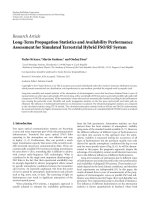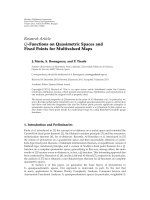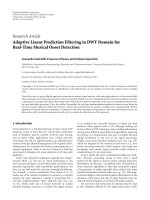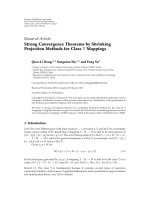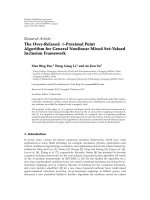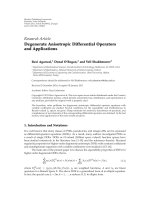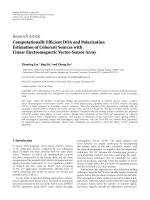báo cáo hóa học:" Research Article Q-Functions on Quasimetric Spaces and Fixed Points for Multivalued Maps" docx
Bạn đang xem bản rút gọn của tài liệu. Xem và tải ngay bản đầy đủ của tài liệu tại đây (513.63 KB, 10 trang )
Hindawi Publishing Corporation
Fixed Point Theory and Applications
Volume 2011, Article ID 603861, 10 pages
doi:10.1155/2011/603861
Research Article
Q-Functions on Quasimetric Spaces and
Fixed Points for Multivalued Maps
J. Mar´ın,S.Romaguera,andP.Tirado
Instituto Universitario de Matem
´
atica Pura y Aplicada, Universidad Polit
´
ecnica de Valencia,
Camino de Vera s/n, 46022 Valencia, Spain
Correspondence should be addressed to S. R omaguera,
Received 14 December 2010; Revised 26 January 2011; Accepted 31 January 2011
Academic Editor: Qamrul Hasan Ansari
Copyright q 2011 J. Mar
´
ın et al. This is an open access article distributed under the Creative
Commons Attribution License, which permits unrestricted use, distribution, and reproduction in
any medium, provided the original work is properly cited.
We discuss several properties of Q-functionsinthesenseofAl-Homidanetal Inparticular,we
prove that the partial metric induced by any T
0
weighted quasipseudometric space is a Q-function
and show that both the Sor g enfrey line and the Kofner plane provide significant examples of
quasimetric spaces for which the associated supremum metric is a Q-function. In this context we
also obtain some fixed point results for multivalued maps by using Bianchini-Grandolfi gauge
functions.
1. Introduction and Preliminaries
Kada et al. introduced in 1 the concept of w-distance on a metric space and extended the
Caristi-Kirk fixed point theorem 2, the Ekeland variation principle 3 and the nonconvex
minimization theorem 4,forw-distances. Recently, Al-Homidan et al. introduced in 5
the notion of Q-function on a quasimetric space and then successfully obtained a Caristi-
Kirk-type fixed point theorem, a Takahashi minimization theorem, an equilibrium version of
Ekeland-type variational principle, and a version of Nadler’s fixed point theorem for a Q-
function on a complete quasimetric space, generalizing in this way, among others, the main
results of 1 because every w-distance is, in fact, a Q-function. This interesting approach has
been continued by Hussain et al. 6, and by Latif and Al-Mezel 7, respectively. In particular,
the authors of 7 have obtained a nice Rakotch-type theorem for Q-functions on complete
quasimetric spaces.
In Section 2 of this paper, we generalize the basic theory of Q-functions to
T
0
quasipseudometric spaces. Our approach is motivated, in part, by the fact that
in many applications to Domain Theory, Complexity Analysis, Computer Science and
Asymmetric Functional Analysis, T
0
quasipseudometric spaces in particular, weightable T
0
2 Fixed Point Theory and Applications
quasipseudometric spaces and their equivalent partial metric spaces rather tha n quasimetric
spaces, play a crucial role cf. 8–23,etc.. In particular, we prove that for every weighted
T
0
quasipseudometric space the induced partial metric is a Q-function. We also show
that the Sorgenfrey line and the Kofner plane provide interesting examples of quasimetric
spaces for which the associated supremum metric is a Q-function. Finally, Section 3 is
devoted to present a new fixed point theorem for Q-functions and multivalued maps on T
0
quasipseudometric spaces, by using Bianchini-Grandolfi gauge functions in the sense of 24.
Our result generalizes and improves, in several ways, well-known fixed point theorems.
Throughout this paper the letter
and ω will denote the set of positive integer
numbers and the set of nonnegative integer numbers, respectively.
Our basic references for quasimetric spaces are 25, 26.
Next we r ecall several pertinent concepts.
By a T
0
quasipseudometric on a set X,wemeanafunctiond : X × X → 0, ∞ such
that for all x, y, z ∈ X,
i dx, ydy, x0 ⇔ x y,
ii dx, z ≤ dx, ydy, z.
A T
0
quasipseudometric d on X that satisfies the stronger condition
i
dx, y0 ⇔ x y
is called a quasimetric on X.
We remark that in the last years several authors used the term “quasimetric” to refer to
a T
0
quasipseudometric and the term “T
1
quasimetric” to refer to a quasimetric in the above
sense.
In the following we will simply write T
0
qpm instead of T
0
quasipseudometric if no
confusion arises.
A T
0
qpm space is a pair X, d such that X is a set and d is a T
0
qpm on X.Ifd is a
quasimetric on X,thepairX, d is then called a quasimetric space.
Given a T
0
qpm d on a set X, the function d
−1
defined by d
−1
x, ydy, x,is
also a T
0
qpm on X, called the conjugate of d,andthefunctiond
s
defined by d
s
x, y
max{dx, y,d
−1
x, y} is a metric on X, called the supremum metric associated to d.
Thus, every T
0
qpm d on X induces, in a natural way, three topologies denoted by τ
d
,
τ
d
−1
,andτ
d
s
, respectively, and defined as follows.
i τ
d
is the T
0
topology on X which has as a base the family of τ
d
-open balls {B
d
x, ε :
x ∈ X, ε > 0},whereB
d
x, ε{y ∈ X : dx, y <ε},forallx ∈ X and ε>0.
ii τ
d
−1
is the T
0
topology on X which has as a base the family of τ
d
−1
-open balls
{B
d
−1
x, ε : x ∈ X, ε > 0},whereB
d
−1
x, ε{y ∈ X : d
−1
x, y <ε},forall
x ∈ X and ε>0.
iii τ
d
s
is the topology on X induced by the metric d
s
.
Note that if d is a quasimetric on X,thend
−1
is also a quasimetric, and τ
d
and τ
d
−1
are
T
1
topologies on X.
Note also that a sequence x
n
n∈
in a T
0
qpm space X, d is τ
d
-convergent resp.,
τ
d
−1
-convergent to x ∈ X if and only if lim
n
dx, x
n
0 resp., lim
n
dx
n
,x0.
It is well known see, for instance, 26, 27 that there exists many different notions of
completeness for quasimetric spaces. In our context we will use the following notion.
Fixed Point Theory and Applications 3
A T
0
qpm space X, d is said to be complete if every Cauchy sequence is τ
d
−1
-
convergent, where a sequence x
n
n∈
is called Cauchy if for each ε>0thereexistsn
ε
∈
such that dx
n
,x
m
<εwhenever m ≥ n ≥ n
ε
.
In this case, we say that d is a complete T
0
qpm on X.
2. Q-Functions on T
0
qpm-Spaces
We start this section by giving the main concept of this paper, which was introduced in 5
for quasimetric spaces.
Definition 2.1. A Q-function on a T
0
qpm space X, d is a function q : X × X → 0, ∞
satisfying the following conditions:
Q1 qx, z ≤ qx, yqy, z,forallx, y, z ∈ X,
Q2 if x ∈ X, M > 0, and y
n
n∈
is a sequence in X that τ
d
−1
-converges to a point y ∈ X
and satisfies qx, y
n
≤ M,foralln ∈ ,thenqx, y ≤ M,
Q3 for each ε>0thereexistsδ>0suchthatqx, y ≤ δ and qx, z ≤ δ imply dy, z ≤
ε.
If X, d is a metric space and q : X × X → 0, ∞ satisfies conditions Q1 and Q3
above and the following condition:
Q2
qx, · : X → 0, ∞ is lower semicontinuous for all x ∈ X,thenq is called a w-
distance on X, dcf. 1.
Clearly d is a w-distance on X, d whenever d is a metric on X.
However, the situation is very different in the quasimetric case. Indeed, it is obvious
that if X, d is a T
0
qpm space, then d satisfies conditions Q1 and Q2,whereas
Example 3.2 of 5 shows that there exists a T
0
qpm space X, d such that d does not satisfy
condition Q3, and hence it is not a Q-function on X, d.Inthisdirection,wenextpresent
some positive results.
Lemma 2.2. Let q be a Q-function on a T
0
qpm space X, d.Then,foreachε>0,thereexistsδ>0
such that qx, y ≤ δ and qx, z ≤ δ imply d
s
y, z ≤ ε.
Proof. By condition Q3, dy, z ≤ ε. Interchanging y and z, it follows that dz, y ≤ ε,so
d
s
y, z ≤ ε.
Proposition 2 .3. Let X, d be a T
0
qpm space. If d is a Q-function on X, d,thenτ
d
τ
d
s
,and
hence, τ
d
is a metrizable topology on X.
Proof. Let x
n
n∈
be a sequence in X which is τ
d
-convergent to some x ∈ X. Then, by
Lemma 2.2, lim
n
d
s
x, x
n
0. We conclude that τ
d
τ
d
s
.
Remark 2.4. It follows from Proposition 2.3 that many paradigmatic quasimetrizable
topological spaces X, τ, as the Sorgenfrey line, the Michael line, the Niemytzki plane and
the Kofner plane see 25, do not admit any compatible quasimetric d which is a Q-function
on X, d.
In the sequel, we show that, nevertheless, it is possible to construct an easy but, in
several cases, useful Q-function on any quasimetric space, as well as a suitable Q-functions
on any weightable T
0
qpm space.
4 Fixed Point Theory and Applications
Recall that the discrete metric on a set X is the metric d
01
on X defined as d
01
x, x0,
for all x ∈ X,andd
01
x, y1, for all x, y ∈ X with x
/
y.
Proposition 2.5. Let X, dbe a quasimetric space. Then, the discrete metric on Xis a Q-function on
X, d.
Proof. Since d
01
is a metric it obviously satisfies condition Q1 of Definition 2.1.
Now suppose that y
n
n∈
is a sequence in X that τ
d
−1
-converges to some y ∈ X,and
let x ∈ X and M>0suchthatd
01
x, y
n
≤ M,foralln ∈ .IfM ≥ 1, then d
01
x, y ≤ M.If
M<1, we deduce that x y
n
,foralln ∈ . Since lim
n
dy
n
,y0, it follows that dx, y0,
so x y,andthusd
01
x, y0 <M. Hence, condition Q2 is also satisfied.
Finally, d
01
satisfies condition Q3 taking δ 1/2 for every ε>0.
Example 2.6. On the set of real numbers define d : × → 0, 1 as dx, y1ifx>y,
and dx, ymin{y − x, 1} if x ≤ y. Then, d is a quasimetric on
and the topological space
,τ
d
is the celebrated Sorgenfrey line. Since d
s
is the discrete metric on , i t follows from
Proposition 2.5 that d
s
is a Q-function on ,d.
Example 2.7. The quasimetric d on the plane
2
, constructed in Example 7.7 of 25, verifies
that
2
,τ
d
is the so-called Kofner plane and that d
s
is the discrete metric on
2
,so,by
Proposition 2.5, d
s
is a Q-function on
2
,d.
Matthews introduced in 14 the notion of a weightable T
0
qpm space under the name
of a “weightable quasimetric space”, and its equivalent partial metric space, as a part of the
study of denotational semantics of dataflow networks.
A T
0
qpm space X, d is called weightable if there exists a function w : X → 0, ∞
such that for all x, y ∈ X, dx, ywxdy, xwy. In this case, we say that d is a
weightable T
0
qpm on X. The function w is said to be a weighting function for X, d and the
triple X, d, w is called a weighted T
0
qpm space.
A partial metric on a set X is a function p : X ×X → 0, ∞ such that, for all x, y, z ∈ X:
i x y ⇔ px, xpx, ypy, y,
ii px, x ≤ px, y,
iii px, ypy, x,
iv px, z ≤ px, ypy, z − py, y.
A partial metric space is a pair X, p such that X is a set and p is a partial metric on X.
Each partial metric p on
X induces a T
0
topology τ
p
on X which has as a base the family
of open p-balls {B
p
x, ε : x ∈ X, ε > 0},whereB
p
x, ε{y ∈ X : px, y <ε px, x},for
all x ∈ X and ε>0.
The precise relationship between partial metric spaces and weightable T
0
qpm spaces
is provided in the next result.
Theorem 2.8 Matthews 14. a Let X, d be a weightable T
0
qpm space with weighting
function. Then, the function p
d
: X × X → 0, ∞ defined by p
d
x, ydx, ywx, for all
x, y ∈ X, is a partial metric on X. Furthermore τ
d
τ
p
d
.
b Conversely, let X, p be a partial metric space. Then, t he function d
p
: X × X → 0, ∞
defined by d
p
x, ypx, y − px, x, for all x, y ∈ X is a weightable T
0
qpm on X with weighting
function w given by wxpx, x for all x ∈ X. Furthermore τ
p
τ
d
p
.
Fixed Point Theory and Applications 5
Remark 2.9. The domain of words, the interval domain, and the complexity quasimetric space
provide distinguished examples of theoretical computer science that admit a structure of a
weightable T
0
qpm space and, thus, of a partial metric space see, e.g., 14, 20, 21.
Proposition 2.10. Let X, d, w be a weighted T
0
qpm space. Then, the induced partial metric p
d
is a
Q-function on X, d.
Proof. We will show that p
d
satisfies conditions Q1, Q2,andQ3 of Definition 2.1.
Q1 Let x, y, z ∈ X,then
p
d
x, z
≤ p
d
x, y
p
d
y, z
− p
d
y, y
≤ p
d
x, y
p
d
y, z
. 2.1
Q2 Let y
n
n∈
be a sequence in X which is τ
d
−1
-convergent to some y ∈ X.Letx ∈ X
and M>0suchthatp
d
x, y
n
≤ M,foralln ∈ .
Choose ε>0. Then, there exists n
ε
∈ such that dy
n
,y <ε,foralln ≥ n
ε
. Therefore,
p
d
x, y
d
x, y
w
x
≤ d
x, y
n
ε
d
y
n
ε
,y
w
x
p
d
x, y
n
ε
d
y
n
ε
,y
<M ε.
2.2
Since ε is arbitrary, we conclude that p
d
x, y ≤ M.
Q3 Given ε>0, put δ ε/2. If p
d
x, y ≤ δ and p
d
x, z ≤ δ, it follows
d
y, z
p
d
y, z
− w
y
≤ p
d
y, z
≤ p
d
y, x
p
d
x, z
≤ 2δ ε.
2.3
3. Fixed Point Results
Given a T
0
qpm space X, d,wedenoteby2
X
the collection of all nonempty subsets of X,by
Cl
d
−1
X the collection of all nonempty τ
d
−1
-closed subsets of X,andbyCl
d
s
X the collection
of all nonempty τ
d
s
-closed subsets of X.
Following Al-Homidan et al. 5,Definition6.1 if X, d is a quasimetric space, we
say that a multivalued map T : X → 2
X
is q-contractive if there exists a Q-function q on
X, d and r ∈ 0, 1 such that for each x, y ∈ X and u ∈ Tx, there is v ∈ Ty satisfying
qu, v ≤ rqx, y.
Latif and Al-Mezel see 7 generalized this notion as follows.
If X, d is a quasimetric space, we say that a multivalued map T : X → 2
X
is
generalized q-contractive if there exists a Q-function q on X, d such that for each x, y ∈ X
and u ∈ Tx, there is v ∈ Ty satisfying
q
u, v
≤ k
q
x, y
q
x, y
, 3.1
where k : 0, ∞ → 0, 1 is a function such that lim sup
r → t
kr < 1forallt ≥ 0.
6 Fixed Point Theory and Applications
Then, they proved the following improvement of the celebrated Rakotch fixed point
theorem see 28.
Theorem 3.1 Lafit and Al-Mezel 7,Theorem2.3. Let X, d be a complete quasimetric space.
Then, for each generalized q-contractive multivalued map T : X → Cl
d
−1
X there exists z ∈ X such
that z ∈ Tz.
On the other hand, Bianchini and Grandolfi proved in 29 the following fixed point
theorem.
Theorem 3.2 Bianchini and Grandolfi 29. Let X, d be a complete metric space and let T :
X → X be a map such that for each x, y ∈ X
d
T
x
,T
y
≤ ϕ
d
x, y
, 3.2
where ϕ : 0, ∞ → 0, ∞ is a nondecreasing function satisfying
∞
n0
ϕ
n
t < ∞, for all t>0 ( ϕ
n
denotes the nth iterate of ϕ). Then, T has a unique fixed point.
Afunctionϕ : 0, ∞ → 0, ∞ satisfying the conditions of the preceding theorem is
called a Bianchini-Grandolfi gauge function cf 24, 30.
It is easy to check see 30,Page8 that if ϕ is a Bianchini-Grandolfi gauge function,
then ϕt <t,forallt>0, and hence ϕ00.
Our next result generalizes Bianchini-Grandolfi’s theorem for Q-functions on complete
T
0
qpm spaces.
Theorem 3.3. Let X, d be a complete T
0
qpm space, q a Q-function on X,andT : X → Cl
d
s
X a
multivalued map such that for each x, y ∈ X and u ∈ Tx,thereisv ∈ Ty satisfying
q
u, v
≤ ϕ
q
x, y
, 3.3
where ϕ : 0, ∞ → 0, ∞ is a Bianchini-Grandolfi gauge function. Then, there exists z ∈ X such
that z ∈ Tz and qz, z0.
Proof. Fix x
0
∈ X and let x
1
∈ Tx
0
. By hypothesis, there exists x
2
∈ Tx
1
such that
qx
1
,x
2
≤ ϕqx
0
,x
1
. Following this process, we obtain a sequence x
n
n∈ω
with x
n
∈
Tx
n−1
and qx
n
,x
n1
≤ ϕqx
n−1
,x
n
,foralln ∈ . Therefore
q
x
n
,x
n1
≤ ϕ
n
q
x
0
,x
1
, 3.4
for all n ∈
.
Now, choose ε>0. Let δ δε ∈ 0,ε for which condition Q3 is satisfied. We will
show that there is n
δ
∈ such that qx
n
,x
m
<δwhenever m>n≥ n
δ
.
Indeed, if qx
0
,x
1
0, then ϕqx
0
,x
1
0andthusqx
n
,x
n1
0, for all n ∈ ,so,
by condition Q1, qx
n
,x
m
0 whenever m>n.
Fixed Point Theory and Applications 7
If qx
0
,x
1
> 0,
∞
n0
ϕ
n
qx
0
,x
1
< ∞,sothereisn
δ
∈ such that
∞
nn
δ
ϕ
n
q
x
0
,x
1
<δ. 3.5
Then, for m>n≥ n
δ
,wehave
q
x
n
,x
m
≤ q
x
n
,x
n1
q
x
n1
,x
n2
··· q
x
m−1
,x
m
≤ ϕ
n
q
x
0
,x
1
ϕ
n1
q
x
0
,x
1
··· ϕ
m−1
q
x
0
,x
1
≤
∞
jn
δ
ϕ
j
q
x
0
,x
1
<δ.
3.6
In pa rticular, qx
n
δ
,q
n
≤ δ and qx
n
δ
,q
m
≤ δ whenever n,m>n
δ
, so, by Lemma 2.2,
d
s
x
n
,x
m
≤ ε whenever n, m > n
δ
.
We have proved that x
n
n∈ω
is a Cauchy sequence in X, din fact, it is a Cauchy
sequence in the metric space X, d
s
.SinceX, d is complete there exists z ∈ X such that
lim
n
dx
n
,z0.
Next, we show that z ∈ Tz.
To this end, we first prove that lim
n
qx
n
,z0. Indeed, choose ε>0. Fix n ≥ n
δ
.Since
qx
n
,x
m
≤ δ whenever m>n, it follows from condition Q2 that qx
n
,z ≤ δ<εwhenever
n ≥ n
δ
.
Now for each n ∈
take y
n
∈ Tz such that
q
x
n
,y
n
≤ ϕ
q
x
n−1
,z
. 3.7
If qx
n−1
,z0, it follows that qx
n
,y
n
0.Otherwiseweobtainqx
n
, y
n
<qx
n−1
,z.
Hence, lim
n
qx
n
,y
n
0, and by Lemma 2.2,
lim
n
d
s
z, y
n
0. 3.8
Therefore, z ∈ Cl
d
s
Tz Tz.
It remains to prove that qz, z0.
Since z ∈ Tz, we can construct a sequence z
n
n∈
in X such that z
1
∈ Tz,z
n1
∈
Tz
n
and
q
z, z
n
≤ ϕ
n
q
z, z
, ∀n ∈
. 3.9
Since
∞
n0
ϕ
n
qz, z < ∞, it follows that lim
n
ϕ
n
qz, z 0, and thus lim
n
qz, z
n
0. So, by Lemma 2.2, z
n
n∈
is a Cauchy sequence in X, din fact, it is a Cauchy sequence in
X, d
s
.Letu ∈ X such that lim
n
dz
n
,u0. Given ε>0, there is n
ε
∈ such that qz, z
n
≤
ε,foralln ≥ n
ε
. By applying condition Q2,wededucethatqz, u ≤ ε,soqz, u0. Since
lim
n
qx
n
,z0, it follows from condition Q1 that lim
n
qx
n
,u0. Therefore, d
s
z, u ≤ ε,
for all ε>0, by condition Q3.Weconcludethatz u,andthusqz, z0.
8 Fixed Point Theory and Applications
The next example illustrates Theorem 3.3.
Example 3.4. Let X 0,π and let d be the T
0
qpm on X given by dx, ymax{y −x, 0}.Itis
well known that d is weightable with weighting function w given by wxx,forallx ∈ X.
Let q be partial metric induced by d. Then, q is a Q-function on X, d by Proposition 2.10.
Note also that, by Theor em 2.8 a,
q
x, y
max
y − x, 0
x max
x, y
, 3.10
for all x, y ∈ X.MoreoverX, d is clearly complete because d
s
is the Euclidean metric on X
and thus X, d
s
is a compact metric space.
Now define T : X → Cl
d
s
X by
T
x
{
0
}
∪
sin
x
2n
: n ∈
, 3.11
for all x ∈ X.NotethatTx /∈ Cl
d
−1
X because the nonempty τ
d
−1
-closed subsets of X are
the intervals of the form 0,x, x ∈ X.
Let ϕ : 0, ∞ → 0, ∞ be such that ϕtsint/2,forallt ∈ 0,π,andϕtt/2,
for all t>π. We wish to show that ϕ is a Bianchini-Grandolfi gauge function.
It is clear that ϕ is nondecreasing.
Moreover,
∞
n0
ϕ
n
t < ∞,forallt ≥ 0. Indeed, if t>πwe have ϕ
n
t ≤ t/2
n
whenever
n ∈ ω, while for t ∈ 0,π,wehaveϕt ≤ t/2so,
ϕ
2
t
ϕ
ϕ
t
sin
ϕ
t
2
≤ sin
t
4
≤
t
4
,
3.12
and following this process we deduce the known fact that ϕ
n
t ≤ t/2
n
,foralln ∈ .Wehave
shown that ϕ is a Bianchini-Grandolfi gauge function.
Finally, for each x, y ∈ X and u ∈ Tx \{0},thereexistsn ∈
such that u sinx/2n.
Choose v siny/2n.Thenv ∈ Ty and
q
u, v
max
sin
x
2n
, sin
y
2n
≤ max
sin
x
2
, sin
y
2
sin
max
x, y
2
ϕ
max
x, y
ϕ
q
x, y
.
3.13
If u 0, then u ∈ Ty,andthusqu, u0 ≤ ϕqx, y.
We have checked that conditions of Theorem 3.3 are fulfilled , and hence, there is z ∈
Tz with qz, z0. In fact z 0 is the only point of X satisfying qz, z0andz ∈ Tz
actually {z} Tz. The following consequence of Theorem 3.3, which is also illustrated by
Example 3.4, improves and generalizes in several directions the Banach Contraction Principle
for partial metric spaces obtained in Theorem 5.3 of 14.
Fixed Point Theory and Applications 9
Corollary 3.5. Let X, p be a partial metric space such that the induced weightable T
0
qpm d
p
is
complete and let T : X → Cl
d
s
X be a multivalued map such that for each x, y ∈ X and u ∈ Tx,
there is v ∈ Ty satisfying
p
u, v
≤ ϕ
p
x, y
, 3.14
where ϕ : 0, ∞ → 0, ∞ is a Bianchini-Grandolfi gauge function. Then, there exists z ∈ X such
that z ∈ Tz and pz, z0.
Proof. Since p p
d
p
see Theorem 2.8, we deduce from Proposition 2.10 that p is a Q-
function for the complete weightable T
0
qpm space X, d
p
. The conclusion follows from
Theorem 3.3.
Observe that if k : 0, ∞ → 0, 1 is a nondecreasing function such that
lim sup
r → t
kr < 1, for all t ≥ 0, then the function ϕ : 0, ∞ → 0, ∞ given by ϕt
ktt, is a Bianchini-Grandolfi gauge function compare 31,Proposition8. Therefore, the
following variant of Theorem 3.1, which improves Corollary 2.4 of 7, is now a consequence
of Theorem 3.3.
Corollary 3.6. Let X, d be a complete T
0
qpm space. Then, for each generalized q-contractive
multivalued map T : X → Cl
d
s
X with q nondecreasing, there exists z ∈ X such that z ∈ Tz and
qz, z0.
Remark 3.7. The proof of Theorem 3.3 shows that the condition that X, d is complete can
be replaced by the more general condition that every Cauchy sequence in the metric space
X, d
s
is τ
d
−1
-convergent.
Acknowledgments
The authors thank one of the reviewers for suggesting the inclusion of a concrete example to
which Theorem 3.3 applies. They acknowledge the support of the Spanish Ministry of Science
and Innovation, Grant no. MTM2009-12872-C02-01.
References
1 O. Kada, T. Suzuki, and W. Takahashi, “Nonconvex minimization theorems and fixed point theorems
in complete metric spaces,” Mathematica Japonica, vol. 44, no. 2, pp. 381–391, 1996.
2 J. Caristi and W. A. Kirk, “Geometric fixed point theory and inwardness conditions,” in The Geometry
of Metric and L inear Spaces, vol. 490 of Lecture Notes in Mathematics, pp. 74–83, Springer, Berlin,
Germany, 1975.
3 I. Ekeland, “Nonconvex minimization problems,” Bulletin of the American Mathematical Society,vol.1,
no. 3, pp. 443–474, 1979.
4 W. Takahashi, “Existence theorems generalizing fixed point theorems for multivalued mappings,” in
Fixed Point Theory and Applications,M.A.Th
´
era and J. B. Baillon, Eds., vol. 252 of Pitman Research Notes
in Mathematics Series, pp. 397–406, Longman, Harlow, UK, 1991.
5 S. Al-Homidan, Q. H. Ansari, and J C. Yao, “Some generalizations of Ekeland-type variational
principle with applications to equilibrium problems and fixed point theory,” Nonlinear Analysis:
Theory, Methods & Applications, vol. 69, no. 1, pp. 126–139, 2008.
6 N. Hussain, M. H. Shah, and M. A. Kutbi, “Coupled coincidence point theorems for nonlinear
contractions in partially ordered quasi-metric spaces with a Q-function,” Fixed Point Theory and
Applications, vol. 2011, Article ID 703938, 21 pages, 2011.
10 Fixed Point Theory and Applications
7 A. Latif and S. A. Al-Mezel, “Fixed point results in quasimetric spaces,” Fixed Point Theory and
Applications, vol. 2011, Article ID 178306, 8 pages, 2011.
8 C. Alegre, “Continuous operators on asymmetric normed spaces,” Acta Mathematica Hungarica,vol.
122, no. 4, pp. 357–372, 2009.
9 M. Ali-Akbari, B. Honari, M. Pourmahdian, and M. M. Rezaii, “The space of formal balls and models
of quasi-metric spaces,” Mathematical Structures in Computer Science, vol. 19, no. 2, pp. 337–355, 2009.
10 S. Cobzas¸, “Compact and precompact sets in a symmetric locally convex spaces,” Topology and its
Applications, vol. 156, no. 9, pp. 1620–1629, 2009.
11 L. M. Garc
´
ıa-Raffi,S.Romaguera,andE.A.S
´
anchez-P
´
erez, “The Goldstine theorem for asymmetric
normed linear spaces,” Topology and its Applications, vol. 156, no. 13, pp. 2284–2291, 2009.
12 L. M. Garc
´
ıa-Raffi, S. Romaguera, and M. P. Schellekens, “Applications of the complexity space to the
general probabilistic divide and conquer algorithms,” Journal of Mathematical Analysis and Applications,
vol. 348, no. 1, pp. 346–355, 2008.
13 R. Heckmann, “Approximation of metric spaces by partial metric spaces,” Applied Categorical
Structures, vol. 7, no. 1-2, pp. 71–83, 1999.
14 S. G. Matthews, “Partial metric topology,” in Proceedings of the 14th Summer Conference on General
Topology and Its Applications, vol. 728 of Annals of the New Yo rk Academy of Sciences, pp. 183–197, The
New York Academy of Sciences, 1994.
15 S. Romaguera, “On computational models for the hyperspace,” in Advances in Mathematics Resear ch.
Vol. 8, Advances in Mathematics, pp. 277–294, Nova Science, New York, NY, USA, 2009.
16 S. Romaguera and M. Schellekens, “Partial metric monoids and semivaluation spaces,” Topology and
its Applications, vol. 153, no. 5-6, pp. 948–962, 2005.
17 S. Romaguera and P. Tirado, “The complexity probabilistic quasi-metric space,” Journal of Mathematical
Analysis and Applications, vol. 376, no. 2, pp. 732–740, 2011.
18
S. Romaguera and O. Valero, “A quantitative computational model for complete partial metric spaces
via formal balls,” Mathematical Structures in Computer Science, vol. 19, no. 3, pp. 541–563, 2009.
19 S. Romaguera and O. Valero, “Domain theoretic characterisations of quasi-metric completeness in
terms of formal balls,” Mathematical Structures in Computer Science, vol. 20, no. 3, pp. 453–472, 2010.
20 M. Schellekens, “The Smyth completion: a common foundation for denotational semantics and
complexity analysis,” in Mathematical Foundations of Programming Semantics (New Orleans, LA, 1995),
vol. 1 of Electr onic Notes in Theoretical Computer Science, pp. 535–556, Elsevier, Amsterdam, The
Netherlands, 1995.
21 M. P. Schellekens, “A characterization of partial metrizability: domains are quantifiable,” Theoretical
Computer Science, vol. 305, no. 1–3, pp. 409–432, 2003.
22 P. Waszkiewicz, “Quantitative continuous domains,” Applied Categorical Structures,vol.11,no.1,pp.
41–67, 2003.
23 P. Waszkiewicz, “Partial metrisability of continuous posets,” Mathematical Structur es in Computer
Science, vol. 16, no. 2, pp. 359–372, 2006.
24 P. D. Proinov, “A generalization of the Banach contraction principle with high order of convergence
of successive approximations,” Nonlinear Analysis: Theory, Methods & Applications,vol.67,no.8,pp.
2361–2369, 2007.
25 P. Fletcher and W. F. Lindgren, Quasi-Uniform Spaces,vol.77ofLecture Notes in Pure and Applied
Mathematics, Marcel Dekker, New York, NY, USA, 1982.
26 H P. A. K
¨
unzi, “Nonsymmetric distances and their associated topologies: about the o rigins of basic
ideas in the area of asymmetric topology,” in Handbook of the History of General Topology, Vol. 3,vol.3
of History of Topology, pp. 853–968, Kluwer Academic Publishers, Dordrecht, The Netherlands, 2001.
27 I. L. Reilly, P. V. Subrahmanyam, and M. K. Vamanamurthy, “Cauchy sequences in quasipseudometric
spaces,” Monatshefte f
¨
ur Mathematik, vol. 93, no. 2, pp. 127–140, 1982.
28 E. Rakotch, “A note on contractive mappings,” Proceedings of the American Mathematical Society,vol.
13, pp. 459–465, 1962.
29 R. M. Bianchini and M. Grandolfi, “Trasformazioni di tipo contrattivo generalizzato in uno spazio
metrico. ,” Atti della Accademia Nazionale dei Lincei, vol. 45, pp. 212–216, 1968.
30 P. D. Proinov, “New general convergence theory for iterative processes and its applications to
Newton-Kantorovich type theorems,” Journal of Complexity, vol. 26, no. 1, pp. 3–42, 2010.
31 T. H. Chang, “Common fixed point theorems for multivalued mappings,” Mathematica Japonica,vol.
41, no. 2, pp. 311–320, 1995.

